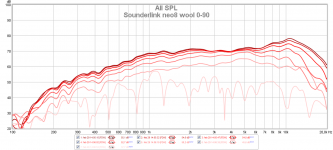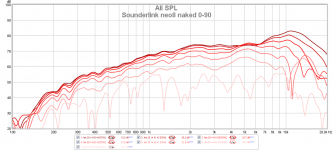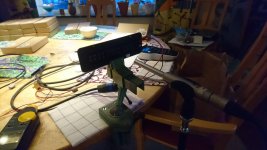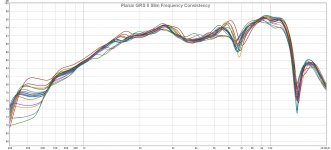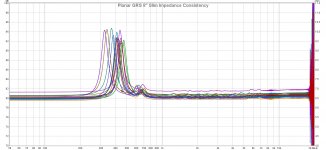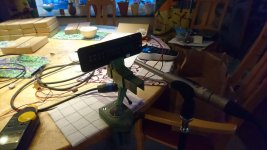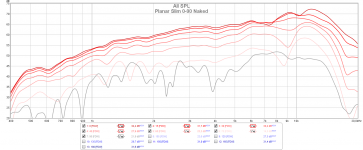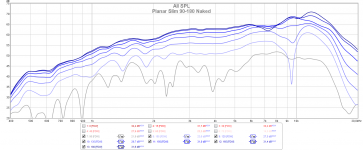The only off-axis SLIM-8 results (that I have seen) appear to be from covering up the outside slots on a wool/felt baffle. Wouldn't this have the same effect on the normal 8's ???
I can verify that the same trick works on a normal Neo8, it does extend the high end a bit. I have gotten more smooth results with a less wide baffle though, on the order of 10 cm or less. This 30 cm baffle is a bit extreme but I wanted to specifically test the extreme case in that measurement.
With a smaller baffle that covers ~ 10 cm and that covers the outermost two holes we get the following on a Sounderlink Neo8 which is basically the GRS wide 8" but more expensive, more distortion and less consistency*. (*My guess based on the consistency of the slims, probably similar for the other planar drivers from GRS)
Note that even with those tricks the top end at 10 khz and above is still worse than the slim. Not by a huge amount sure but a bit worse.
There is also the fact that the wide 8" is well, more wide
The slim driver has a lot less baffle but the same radiating area, so this null is pushed higher in frequency which is a good thing. I believe with some tweaking of the wool baffle (mostly reducing width or curving it to create a mini-waveguide) and with more drivers I can eliminate the null with the slim driver.
Attachments
Has anyone measured the little 3.5" tweeter?
Dayton Audio PTMini-6 Planar Tweeter 6 Ohm
Sensitivity doesn't look great, no idea about distortion. But I'm wondering how a couple of these would do with 8" planar slim on either side?
I measured them and even in a full line array your looking at around 4.5khz at best distortion wise. Horizontal dispersion is excellent though.
Spoke to the OH yesterday and just placed my order for enough Slims to make a stereo pair of floor to ceiling array. Since seeing StigErik's succes with the RD75, years ago, I have been willing to do something similar, and i think that currently it is only these Slim units that can actually come close to the RD75.
This is gonna be cool!!
New First Built Advice
Its great to find this thread. I'm think of getting the GRS PT6816-8 with 4 per side hopefully to get a low cut off around 400-500Hz so most vocals will be on the planar and coupled with 2 Dayton Audio RS225P 8 inch. This is my first planar experience/built so I have a few questions if you can help me with.
1) I picked the GRS slims as both lower and upper FR seems more even than the wider versions. Would this planar sound more like a metal or textile dome? I tend towards textile as they seem to sound more realistic/natural.
2) Related would be if AL or paper cone woofer be better tonal match.
3) I was thinking of using 2x 8 inch in a slim enclosure but to get low bass would have to be enclosed. Would the transition between enclosed bass to open planar have audible tonal change? Should I go OB with 2 10 or 12 inch instead for best tonal consistency?
Thanks in advance for your help!
Its great to find this thread. I'm think of getting the GRS PT6816-8 with 4 per side hopefully to get a low cut off around 400-500Hz so most vocals will be on the planar and coupled with 2 Dayton Audio RS225P 8 inch. This is my first planar experience/built so I have a few questions if you can help me with.
1) I picked the GRS slims as both lower and upper FR seems more even than the wider versions. Would this planar sound more like a metal or textile dome? I tend towards textile as they seem to sound more realistic/natural.
2) Related would be if AL or paper cone woofer be better tonal match.
3) I was thinking of using 2x 8 inch in a slim enclosure but to get low bass would have to be enclosed. Would the transition between enclosed bass to open planar have audible tonal change? Should I go OB with 2 10 or 12 inch instead for best tonal consistency?
Thanks in advance for your help!
You're asking for opinions, and that's what I'm giving, along with some generalities and assumptions going from limited information in your post. My thoughts may be different than yours on various goals, so none of this is set in stone or applies to all speakers.
I think that cross point may be stretching things a bit. While frequency response is relatively smooth down there, the distortion plot in post 97 of this thread shows rapidly increasing distortion below 800 Hz (below about 600 Hz it exceeds the values seen across the rest of the driver's range). How much distortion you're willing to live with will help make the decision on the crossover point. Some people see increasing distortion at the bottom of a tweeter's range as tolerable because they value some other performance aspect more. A very steep crossover should help if you want to push it.
Many people like aluminum cone drivers for their increased detail retrieval. That aspect would likely be a better fit with the planar. Most aluminum cones have pretty nasty breakup regions that must be avoided though. These are typically in the 2.5-5 kHz range depending on size and design. Probably won't be much of an issue for what you're planning unless you use a shallow crossover and pick the wrong midrange/woofer. Paper cones tend to have smoother frequency response, but a more mellow presentation. If that's what you value more, that may sway your choice.
You didn't say what kind of enclosure you're planning. Two 8's in a sealed enclosure typically won't go that low (depending on your definition of low). Open baffle can get complicated pretty fast - many choices and trade-offs have to be made there. They aren't as simple as they first appear if you're going for high performance and/or high output. It's not so much the tonality that's the problem in this scenario, it's the polar response/dipole response on top vs. monopole bottom end. The lower your crossover, the better from this standpoint.
I think that cross point may be stretching things a bit. While frequency response is relatively smooth down there, the distortion plot in post 97 of this thread shows rapidly increasing distortion below 800 Hz (below about 600 Hz it exceeds the values seen across the rest of the driver's range). How much distortion you're willing to live with will help make the decision on the crossover point. Some people see increasing distortion at the bottom of a tweeter's range as tolerable because they value some other performance aspect more. A very steep crossover should help if you want to push it.
Many people like aluminum cone drivers for their increased detail retrieval. That aspect would likely be a better fit with the planar. Most aluminum cones have pretty nasty breakup regions that must be avoided though. These are typically in the 2.5-5 kHz range depending on size and design. Probably won't be much of an issue for what you're planning unless you use a shallow crossover and pick the wrong midrange/woofer. Paper cones tend to have smoother frequency response, but a more mellow presentation. If that's what you value more, that may sway your choice.
You didn't say what kind of enclosure you're planning. Two 8's in a sealed enclosure typically won't go that low (depending on your definition of low). Open baffle can get complicated pretty fast - many choices and trade-offs have to be made there. They aren't as simple as they first appear if you're going for high performance and/or high output. It's not so much the tonality that's the problem in this scenario, it's the polar response/dipole response on top vs. monopole bottom end. The lower your crossover, the better from this standpoint.
Would this planar sound more like a metal or textile dome?
Haven't heard the GRS but Neo planars sound far more like textile than metal domes to my ears.
I would also try to stick with open baffle for bass, and it so happens SB Acoustic is now selling 12" and 15" paper woofers designed for open baffle. At least their graphs look pretty good on top-end response.
SB Audience :: BIANCO-12OB150
Audience Open Baffle Woofers: Madisound Speaker Components
You're asking for opinions, and that's what I'm giving, along with some generalities and assumptions going from limited information in your post.
Thanks for your thoughts. I had build 2 15in RSS390HF in a sealed 3 cf bass box for use as sub in my HT. I'll use that in conjunction with the planars to experiment with crossover point and transient from bipolar to unipolar. Part of my reason to try crossover at 400-500hz is to minimize the transition in voice range.
Any opinions on a cheap all GRS OB using:
GRS PT2522-4 3-1/2" Planar Tweeter 4 Ohm
GRS PT5010-8 10" Planar Mid/Tweeter 8 Ohm
https://www.parts-express.com/GRS-15PF-8-15-Paper-Cone-Foam-Surround-Woofer-292-415
GRS PT2522-4 3-1/2" Planar Tweeter 4 Ohm
GRS PT5010-8 10" Planar Mid/Tweeter 8 Ohm
https://www.parts-express.com/GRS-15PF-8-15-Paper-Cone-Foam-Surround-Woofer-292-415
I'm assuming you're talking about only one of each driver and that you're expecting typical performance levels from your speaker (nearly full-range output, typical listening distances and volumes). If your expectations are different, that changes things.
The Xmax on the GRS 15 looks a bit restricted for open baffle use at very low frequencies.
Depending on where you want to cross the 10" planar to the woofer and how wide you intend the baffle to be, a single 10" planar may not have great output capabilities at the lower end of its frequency range. Crossing at a higher frequency can likely take care of that.
Even with those things said, the combination will likely make for an interesting project that will be more engaging than typical speakers. If you decide you want more output and bass capabilities, adding drivers will usually fix that. Many people wind up back at normal boxed subwoofers to augment dipoles, as the quality of bass is different and it's easier/cheaper to get the lowest frequencies that way.
If this is your first run at a dipole project, a DSP unit and multiple amplifiers is typically the fastest and easiest way to get them going. The flexibility of this kind of setup is handy initially, even if you don't intend to go this route longer term.
The Xmax on the GRS 15 looks a bit restricted for open baffle use at very low frequencies.
Depending on where you want to cross the 10" planar to the woofer and how wide you intend the baffle to be, a single 10" planar may not have great output capabilities at the lower end of its frequency range. Crossing at a higher frequency can likely take care of that.
Even with those things said, the combination will likely make for an interesting project that will be more engaging than typical speakers. If you decide you want more output and bass capabilities, adding drivers will usually fix that. Many people wind up back at normal boxed subwoofers to augment dipoles, as the quality of bass is different and it's easier/cheaper to get the lowest frequencies that way.
If this is your first run at a dipole project, a DSP unit and multiple amplifiers is typically the fastest and easiest way to get them going. The flexibility of this kind of setup is handy initially, even if you don't intend to go this route longer term.
I am amazed that many OB enthusiasts didn't consider the consequences for OB subwoofers.
1. With a baffle width of 1.15m the -3dB will be around 100Hz, so for 25Hz you have to amplify +12dB plus 0.71/Qts ( another 3dB for Qts=0.5)
2. The excursion will be 4 times higher at 25Hz than with a infinite baffle for the same SPL. This has consequences for distortion. You need expensive drivers with high Xlin.
3. The amplifier also needs 4x the voltage or 16x the power rating of an infinite baffle with the same SPL at 25Hz. So even to reach moderate levels you need a really powerful amp.
4. Room reflections double so the placement is usually best far away from corners more in the middle of the room. The baffle size with supports etc will take the same space as a closed box. WAF= 0
5. The ripples and troughs prevent a use above the 1st peak.
I found on the Linkwitz site the reason is that he heard an OB installation 50yrs ago that blew his mind away.
He mentions the requred power and excursion but not the added distortion. "Just" 6dB/octave is quite a bit as shown above.
There are no doubt advantages for midrange speakers because box resonances are eliminated, but the ripples occur also there and require more ways because of less usable bandwidth.
1. With a baffle width of 1.15m the -3dB will be around 100Hz, so for 25Hz you have to amplify +12dB plus 0.71/Qts ( another 3dB for Qts=0.5)
2. The excursion will be 4 times higher at 25Hz than with a infinite baffle for the same SPL. This has consequences for distortion. You need expensive drivers with high Xlin.
3. The amplifier also needs 4x the voltage or 16x the power rating of an infinite baffle with the same SPL at 25Hz. So even to reach moderate levels you need a really powerful amp.
4. Room reflections double so the placement is usually best far away from corners more in the middle of the room. The baffle size with supports etc will take the same space as a closed box. WAF= 0
5. The ripples and troughs prevent a use above the 1st peak.
I found on the Linkwitz site the reason is that he heard an OB installation 50yrs ago that blew his mind away.
He mentions the requred power and excursion but not the added distortion. "Just" 6dB/octave is quite a bit as shown above.
There are no doubt advantages for midrange speakers because box resonances are eliminated, but the ripples occur also there and require more ways because of less usable bandwidth.
Last edited:
Ta for the input gents.
I have no expectations below 50hz for OB bass, having said that, $36 per 15" makes using 2 x 15"s per side very viable.
It would be great to use 2 x 10" Planar Mids per side also but at $129 each that kinda throws the 'cheap' idea out the window.
I have 8 channels of MiniDSP & Amps but would really like to go passive on this one.
Might start a new thread to see how much interest there is. Passive XO is not my strong suit, although I am having fun with XSIM, having trouble getting the response flat on the 10" GRS planar.
Cheers
Dean
I have no expectations below 50hz for OB bass, having said that, $36 per 15" makes using 2 x 15"s per side very viable.
It would be great to use 2 x 10" Planar Mids per side also but at $129 each that kinda throws the 'cheap' idea out the window.
I have 8 channels of MiniDSP & Amps but would really like to go passive on this one.
Might start a new thread to see how much interest there is. Passive XO is not my strong suit, although I am having fun with XSIM, having trouble getting the response flat on the 10" GRS planar.
Cheers
Dean
Starting with one of each driver makes sense, since you have limited bass expectations.
With an open baffle design, the size/shape of the baffle has a large impact on the measured frequency response. That will need to be dealt with also.
Since you have the DSP/amps already, I would definitely start there. The benefit is that you can quickly and easily compensate for baffle-related response, adjust crossover frequencies if your initial guesses are too aggressive, fix sensitivity differences, etc. It will let you get a feel for the potential of your overall design without spending so many hours tweaking passive crossovers. Having the intended filter responses can also make developing a passive crossover easier longer term.
Measurements and simulations only get you so far. Sitting in front of the speaker and listening is the ultimate test, and for me it makes sense to get that done as quickly as possible. Some drivers are just not involving or are problematic for other reasons, and it's hard to see all of that in measurements, especially those provided by the manufacturer. Having a very good listening experience early also tends to keep me motivated on the project.
With an open baffle design, the size/shape of the baffle has a large impact on the measured frequency response. That will need to be dealt with also.
Since you have the DSP/amps already, I would definitely start there. The benefit is that you can quickly and easily compensate for baffle-related response, adjust crossover frequencies if your initial guesses are too aggressive, fix sensitivity differences, etc. It will let you get a feel for the potential of your overall design without spending so many hours tweaking passive crossovers. Having the intended filter responses can also make developing a passive crossover easier longer term.
Measurements and simulations only get you so far. Sitting in front of the speaker and listening is the ultimate test, and for me it makes sense to get that done as quickly as possible. Some drivers are just not involving or are problematic for other reasons, and it's hard to see all of that in measurements, especially those provided by the manufacturer. Having a very good listening experience early also tends to keep me motivated on the project.
While I have not yet build a real speaker with my set of GRS Slim 8" I have gotten around to measuring them for consistency:
Distortion measurement is at ~ 2.6V so ~ 1W. I added a 18 dB highpass filter @ 800 hz. SPL is not calibrated.
The goal of the measurements is not to see the actual performance but rather to detect if I have any bad drivers in the bunch.
REW .mdat of distortion sweeps of all drivers:
Planar Distortion Numbered.mdat - Google Drive
REW .mdat of all driver impedances:
Planar Impedance Numbered.mdat - Google Drive
The driver number on the distortion sweep corresponds with the impedance driver number.
All impedance measurements are in free air (same setup as when measuring distortion) except that for driver 1 where "with wool" means in this setup: New planar drivers at Parts Express.
Conclusion:
No truly bad drivers in the bunch, which far better than I expected. They are all pretty much the same except below 600 hz where they differ somewhat. I only need 14 for my speakers so I will keep the 3 drivers the furthest from the average as spares and use the others for my speakers.
Distortion measurement is at ~ 2.6V so ~ 1W. I added a 18 dB highpass filter @ 800 hz. SPL is not calibrated.
The goal of the measurements is not to see the actual performance but rather to detect if I have any bad drivers in the bunch.
REW .mdat of distortion sweeps of all drivers:
Planar Distortion Numbered.mdat - Google Drive
REW .mdat of all driver impedances:
Planar Impedance Numbered.mdat - Google Drive
The driver number on the distortion sweep corresponds with the impedance driver number.
All impedance measurements are in free air (same setup as when measuring distortion) except that for driver 1 where "with wool" means in this setup: New planar drivers at Parts Express.
Conclusion:
No truly bad drivers in the bunch, which far better than I expected. They are all pretty much the same except below 600 hz where they differ somewhat. I only need 14 for my speakers so I will keep the 3 drivers the furthest from the average as spares and use the others for my speakers.
Attachments
While I have not yet build a real speaker with my 17x of GRS Slim 8" I have gotten around to measuring them for consistency:
Distortion measurement is at ~ 2.6V so ~ 1W. I added a 18 dB highpass filter @ 800 hz.
The goal of the measurements is not to see the actual performance but rather to detect if I have any bad drivers in the bunch.
REW .mdat of distortion sweeps of all drivers (30 MB):
Planar Distortion Numbered.mdat - Google Drive
REW .mdat of all driver impedances (22 MB):
Planar Impedance Numbered.mdat - Google Drive
The driver number on the distortion sweep corresponds with the impedance driver number. The color, however, does not because I am lazy =)
All impedance measurements are in free air (same setup as when measuring distortion) except that for driver 1 where "with wool" means in this setup: New planar drivers at Parts Express.
Conclusion:
No truly bad drivers in the bunch, which far better than I expected. Especially considering how cheap they are. The Sounderlink drivers I've tried, which are more expensive too have nowhere close to this good consistency! They are all pretty much the same except below 600 hz where they differ somewhat. I only need 14 for my speakers so I will keep the 3 drivers the furthest from the average as spares and use the others for my speakers.
Distortion measurement is at ~ 2.6V so ~ 1W. I added a 18 dB highpass filter @ 800 hz.
The goal of the measurements is not to see the actual performance but rather to detect if I have any bad drivers in the bunch.
REW .mdat of distortion sweeps of all drivers (30 MB):
Planar Distortion Numbered.mdat - Google Drive
REW .mdat of all driver impedances (22 MB):
Planar Impedance Numbered.mdat - Google Drive
The driver number on the distortion sweep corresponds with the impedance driver number. The color, however, does not because I am lazy =)
All impedance measurements are in free air (same setup as when measuring distortion) except that for driver 1 where "with wool" means in this setup: New planar drivers at Parts Express.
Conclusion:
No truly bad drivers in the bunch, which far better than I expected. Especially considering how cheap they are. The Sounderlink drivers I've tried, which are more expensive too have nowhere close to this good consistency! They are all pretty much the same except below 600 hz where they differ somewhat. I only need 14 for my speakers so I will keep the 3 drivers the furthest from the average as spares and use the others for my speakers.
Attachments
Last edited:
No truly bad drivers in the bunch, which far better than I expected. Especially considering how cheap they are. The Sounderlink drivers I've tried, which are more expensive too have nowhere close to this good consistency!
The consistency is really good news!
What crossover point/slope are you planning on for your "real" speakers?
The consistency is really good news!
What crossover point/slope are you planning on for your "real" speakers?
I haven't decided yet. When I have an actual speaker I'll just measure and see how high I can cross such that:
- 100 dB SPL @ 1m.
- No significant distortion harmonics above 3rd.
- 3rd harmonic equal or below 2nd harmonic.
I believe that the answer will be an an acoustic slope of 24 dB Linkwitz Riley in the range of 600 - 800 hz.
More measurements, this time 0-180 or the Slim 8" naked in free air:
The goal this time is to determine which side I want facing the front since they are not fully symmetrical as the back has felt on the outer holes. And from the result I'll probably have mine facing front with the terminals facing the back.
The goal this time is to determine which side I want facing the front since they are not fully symmetrical as the back has felt on the outer holes. And from the result I'll probably have mine facing front with the terminals facing the back.
Attachments
While I have not yet build a real speaker with my set of GRS Slim 8" I have gotten around to measuring them for consistency:
Distortion measurement is at ~ 2.6V so ~ 1W. I added a 18 dB highpass filter @ 800 hz. SPL is not calibrated.
The goal of the measurements is not to see the actual performance but rather to detect if I have any bad drivers in the bunch.
REW .mdat of distortion sweeps of all drivers:
Planar Distortion Numbered.mdat - Google Drive
REW .mdat of all driver impedances:
Planar Impedance Numbered.mdat - Google Drive
The driver number on the distortion sweep corresponds with the impedance driver number.
All impedance measurements are in free air (same setup as when measuring distortion) except that for driver 1 where "with wool" means in this setup: New planar drivers at Parts Express.
Conclusion:
No truly bad drivers in the bunch, which far better than I expected. They are all pretty much the same except below 600 hz where they differ somewhat. I only need 14 for my speakers so I will keep the 3 drivers the furthest from the average as spares and use the others for my speakers.
thanks for the effort ! they look rahter consistent. i do think your mic or preamp has trouble with the volume though
- Home
- Loudspeakers
- Planars & Exotics
- New planar drivers at Parts Express
